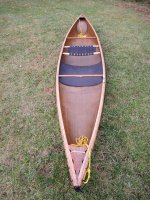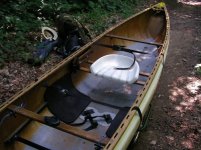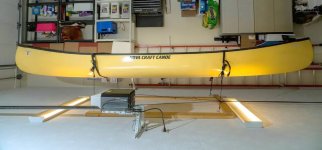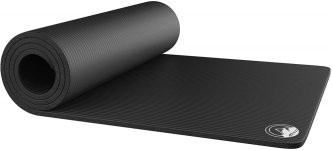I've used acetone many times to clean the exterior and interior of various composite canoes of pond scum, stains and resin blush, and it has never caused any damage. If there's any concern about that, you could test it on a small patch up in the end of the canoe. It's hard to get all the old contact cement off without a solvent.
However, you don't really have to if you are going to cover up the old patch with a new and bigger knee pad. On my Bell Wildfire, I removed the original owner's puny knee pads and glued in a large piece of 3/8" Ensolite sleeping pad foam, gunwale-to-gunwale, so I can crawl around in front of the seat to more effectively heel, rail and pitch the canoe for turning maneuvers.

In my Hemlock SRT, I used two 1/2" custom cut neoprene pads with a water channel through the middle because that canoe is used for tripping and whitewater. I brought the pads up high on the sides, again to facilitate heeling.

For my most recent canoe, a Nova Craft Bob Special . . .

. . . I use an
$18, 1/2" x 72" x 24", textured EVA foam pad from Amazon . . .

. . . which can be cut into two 36" x 24" pads, or four 18" x 24" pads, or one 36" and two 18" pads. The 36" is good for a solo paddler and the 18 inchers are good for tandem paddlers. So far, I have not glued these pads in because this canoe is paddled both forward tandem and solo backward from the bow seat. As removable pads, this is a much less expensive solution than large commercial kneeling pads, of which the following is the least expensive of which I am aware (in three sizes):
Are you looking to buy kneeling pads online? Get the stylish Canoe kneeling pads at comfykayak.com with amazing prices & secure shipping.

comfykayak.com





